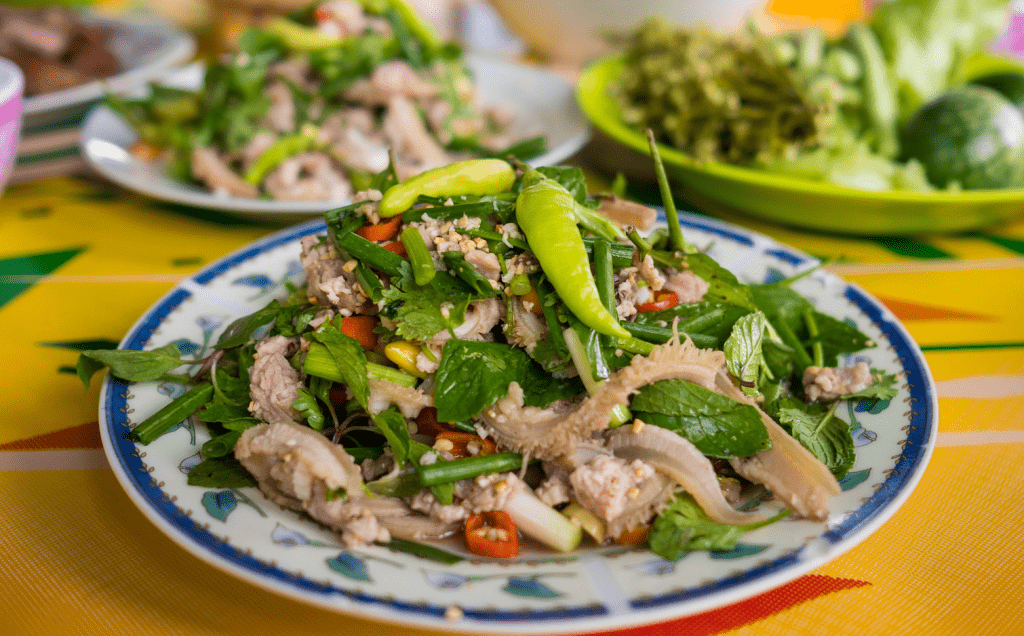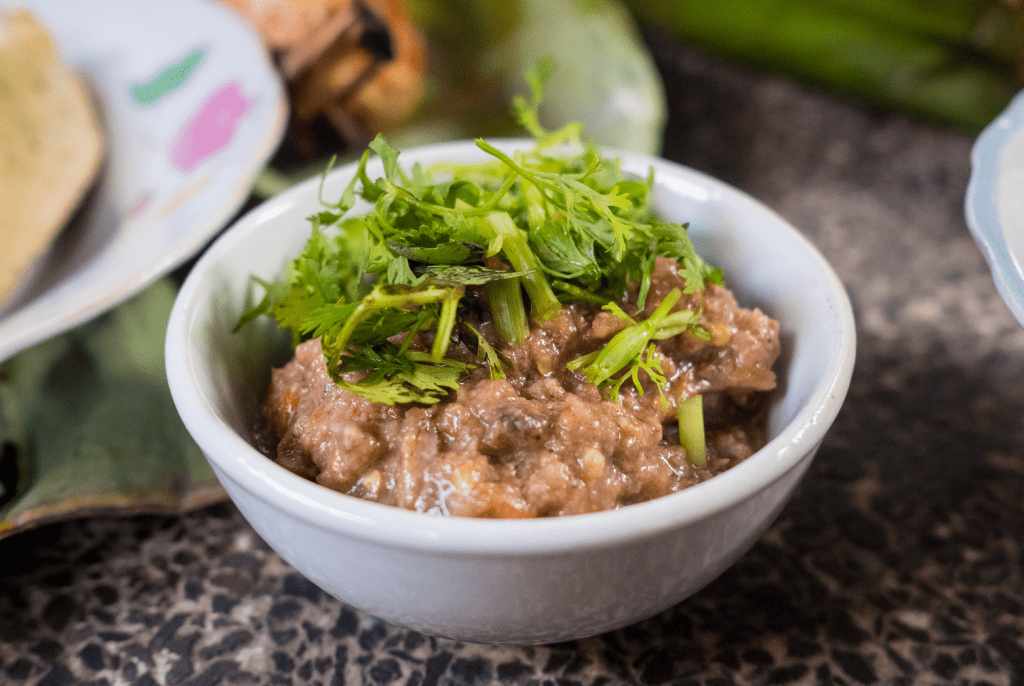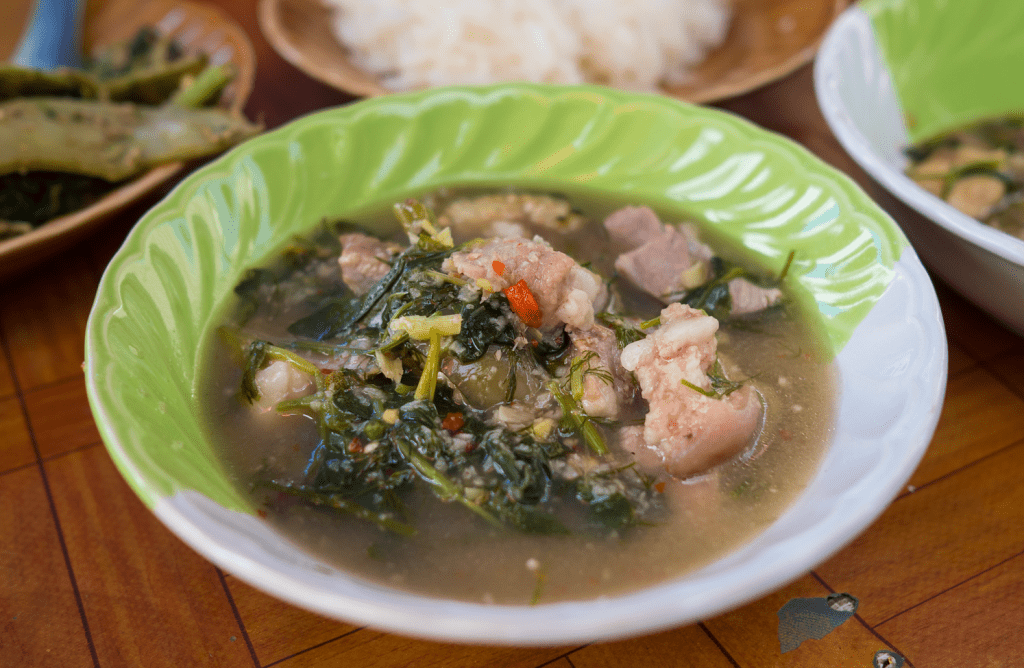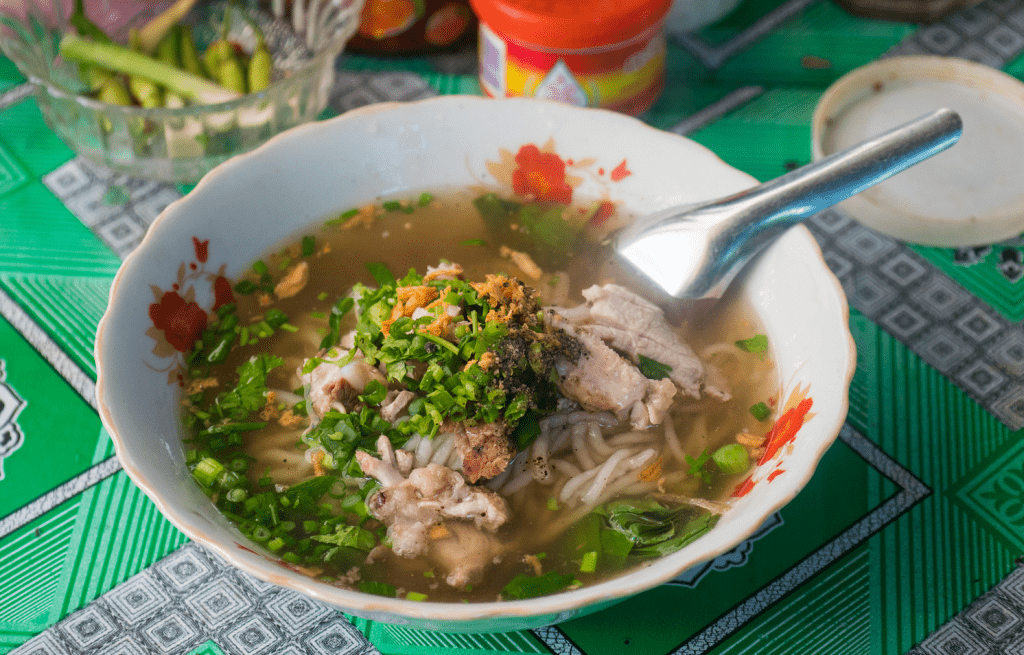Laos, a country nestled in the heart of Southeast Asia, boasts a vibrant tapestry of cuisine that is a feast for the senses. Rich in colors, fragrant with herbs and spices, the diverse combinations of ingredients will undoubtedly tantalize your taste buds.
Laap: The Quintessential Dish
Known as “larb” or “laab” in English, Laap, often translated as a simple “meat salad,” stands as one of Laos’ culinary masterpieces. The term encompasses any freshly prepared meat after slaughter, typically consumed raw—the cornerstone of local cuisine.

Diced meat, be it pork or fish, is swiftly fried or served raw. Fish sauce, fresh herbs (including Lao mint, cilantro, and green onions), lime juice, and roasted glutinous rice powder create a symphony of flavors. Bile, yes, digestive fluid, may even grace Laap, adding a unique bitterness to the dish.
In Laos, Laap tends to be bolder in taste compared to its northeastern Thai counterpart. Pa Kam Tan in Vientiane or Xiengtong in Luang Prabang is recommended for an authentic Laap experience.
Paeng Pet: A Culinary Marvel
Prepare to be amazed by Paeng Pet, a dish in which consuming duck blood, and even pig or goat blood, is commonplace. Duck blood, along with fried minced duck meat and innards, blends with an abundance of Lao herbs—mint, green onions, and cilantro. Crispy shallots and peanuts add texture to this flavor-packed dish.
The refreshing mint, tangy lime, and the fiery kick of local chili create a culinary experience that lingers on your palate. For an unforgettable Paeng Pet, visit Anna Grilled Duck in Vientiane.
Jaew: Dipping Into Flavorful Sauces
Jaew, a term for various dipping sauces, comes in a myriad of types in Laos. Always featuring chili, often with grilled vegetables, these sauces, pounded in a mortar and pestle, offer a unique smoky flavor, sometimes with fermented fish. Jaew Moo, with minced pork and pigskin, resembles Mexico’s Chicharron Tacos.

Jaew bong, another popular dipping sauce, combines dried chilies, garlic, galangal, shallots, and a hint of dried buffalo meat. Look for it in fresh markets or street stalls, as it’s a cherished household dish.
Or Lam: A Flavorful Stew
Or Lam, prepared with animal fat, usually pork, introduces resilient water buffalo skin and Mai Sakaan, an indescribable herb. This earthy concoction, rich with flavors of herbs like coriander or basil, may include game meat, creating a thick, slightly spicy broth. Phamsai Houngchalern in Luang Prabang is a recommended spot for this astonishing dish.

Khao Piak Sen: Satisfying Noodle Soup
Khao Piak Sen, a hearty noodle soup, stands out in Laos and neighboring Vietnam. Thick handmade noodles, not rinsed of their starch, are cooked in a deep meat broth, resulting in a nearly viscous consistency. Fresh herbs, fried chili, shrimp paste, and crushed peanuts complete the dish. Dating back thousands of years, variations like Khao Piak Kao, using rice instead of noodles, offer delightful surprises.

Khao Soi: Not Your Average Curry Noodles
In the laid-back ambiance of Laos, debates likely center on which restaurant serves the best Khao Soi. Diverging from the coconut milk-based Thai version, Lao Khao Soi brings forth the distinct taste of meat, a warm blend of slow-cooked pork, grilled red chili, and chili oil pounded with herbs. The absence of coconut milk allows the rich flavor of the meat to shine through, creating a uniquely warm and savory experience.
Mok Pa: Slow-cooked Lamb Extravaganza
For meat enthusiasts, Mok Pa, slow-cooked lamb wrapped in banana leaves and steamed over charcoal, is a must-try. The unique cooking method imparts a rich flavor to the lamb, enhanced by the natural aroma of banana leaves. Unwrapping the banana leaves at the table adds an element of excitement, revealing succulent meat infused with unforgettable flavors.
Khao Nom Kok: Coconut Rice Cakes
A common street snack, Khao Nom Kok is a traditional delight made from a mixture of coconut milk, glutinous rice, and palm sugar, poured into small circular molds and baked over an open flame. These golden cakes, with a soft interior, boast a fragrant coconut aroma and sweetness. A favorite during festivals, they offer a delightful conclusion to any culinary exploration in Laos.
Mok Pa Sak: Herbal Steamed Fish
A classic Lao dish, Mok Pa Sak, showcases rich herbal flavors and banana leaves in the steaming process. Fish, marinated in an array of herbs, garlic, and chili, is enveloped in banana leaves. The result is a dish bursting with the essence of local herbs like lemongrass and other aromatic spices. The steaming process allows the fish to absorb the fragrances of the herbs and banana leaves, creating a culinary gem.
Lao Hot Pot: A Social Culinary Affair
Laos Hot Pot, a blend of social gathering and gastronomy, graces family dinners and friend gatherings. Featuring an array of meats, fresh vegetables, tofu, and rice noodles, it provides a communal dining experience. The interactive process of dipping raw ingredients into a hot pot and pairing them with delectable sauces such as chili, peanut, and fish sauce not only satisfies taste buds but also strengthens social bonds—an integral tradition in Lao culture.
These culinary wonders showcase the rich and diverse cooking traditions of Laos, captivating food enthusiasts from around the world. In Laos, food is not just a gustatory delight but a cultural conduit for shared experiences and celebrations. Embark on a culinary journey through Laos, where each dish tells a story of tradition, flavor, and community.

Leave a Reply